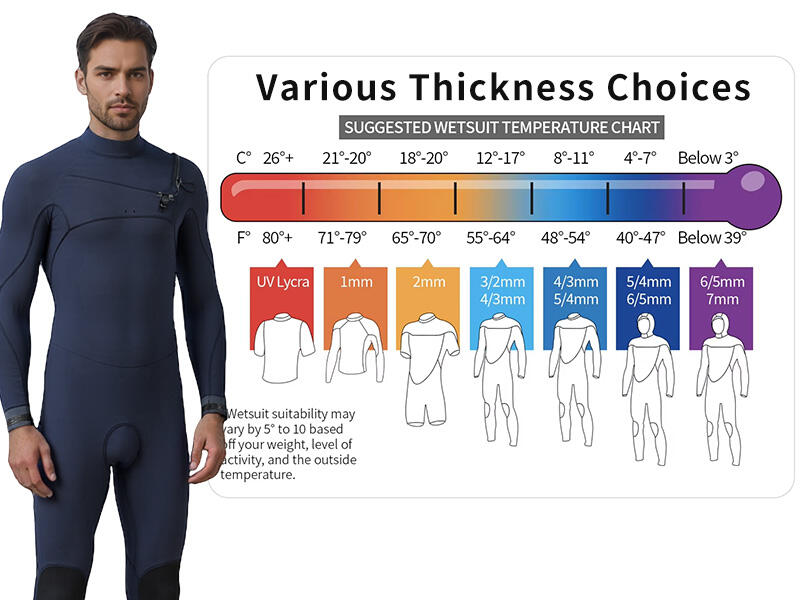הבנת עובי חליפת הים והקשר שלה לטמפרטורת המים
איך בידוד חליפת הים עובד בסביבות מימיות
אופן הפעולה של חליפות רחצה הוא למעשה די מחוכם. הן תופסות כמות קטנה של מים בין העור לחומר הניאופרן, שתחמם לאחר מכן על ידי חום הגוף. מה שמאפשר זאת הוא שהניאופרן מוליך חום לאט בהשוואה לחומרים אחרים כמו פוליאסטר. המספר המדויק? בערך 0.17 וואט למטר-קלווין, כלומר הוא עוזר לנו להישאר חמימים בתנאי מים קרים. הנה הטריק: חליפות עבות מציעות בהחלט בידוד טוב יותר נגד הקור, אך הן גם מקשות על התנועה מתחת למים. מסיבה זו מתעמלים וצללים רבים נמצאים לעתים קרובות במצב של שוקלים את האפשרויות בהתאם לסוג הפעילות שהם עושים וכמה חשובה להם חופש התנועה בסיטואציה הספציפית שלהם.
עובי חליפת רחצה לפי טמפרטורת המים: טווחים מומלצים מ-2/1 ממ עד 5/4 ממ
בחירת העובי המתאים על פי טמפרטורת המים עוזרת למנוע היפותרמיה תוך תמיכה בביצועים:
| טמפרטורת מים | עובי חליפה | דוגמה לפעילות |
|---|---|---|
| 20–24°C (68–75°F) | 1–2 ממ | סקייט סאמר |
| 16–20°C (60–68°F) | 3/2 ממ | צוללות קפיצה |
| 10–16°C (50–60°F) | 4/3 מ"מ | שחייה באוקיינוס הפתוח |
| <10°C (<50°F) | 5/4 מ"מ+ | דייג תת-מימי במים קרים |
משתתפי טריאתלון משתמשים לרוב בחליפות שעוביהן קטן ב-0.5 מ"מ מאלו של צוללנים, בשל ייצור חום מטבולי גבוה יותר במהלך מאמץ ממושך.
פענוח תווית חליפות סיכה: מה פירוש הסימונים 3/2 מ"מ, 4/3 מ"מ ואחרים
הסימון בשני מספרים (למשל 4/3 מ"מ) מתייחס לעובי הנאופרן באזורים מרכזיים:
| אזורֶה | עובי | עדיפות תרמית |
|---|---|---|
| חזה/גב | 4 מ"מ | בידוד איברים חיוניים |
| ידיים/רגליים | 3 מ"מ | אופטימיזציה של תנועתיות |
בנייה אזורית זו משפרת את היעילות התרמית ומצמצמת עייפות ב-22% בהשוואה לבגדים בעלי עובי אחיד במים שתחת 15° צלזיוס (59°F), בהתאם למחקר הידרודינמי.
בחירת חליפת ספונטה עונה לפי עונה: התאמת סוג החליפה לאקלים ולזמן השנה
חליפת ספונטה לקיץ לעומת חורף: התאמה לתנאים טרופיים, מתונים וקרירים
בימי קיץ במים חמים מעל 20 מעלות צלזיוס (כ-68 מעלות פרנייט), חליפות ירידה של 2/1 מ"מ עד 3/2 מ"מ מתאימות ביותר. אלה נותנים לגלושנים ולאוהדי ספורט מים אחרים את החופש הנוסף הדרוש כאשר הם נעים הרבה בגלים. כשהחורף מתקרב, אפשרויות עבותות יותר בין 4/3 מ"מ ל-5/4 מ"מ הופכות נחוצות. הם מתמקדים בהישארת הגוף חם דרך אזורים עבה יותר בחזה ובתפרים סגורים יותר כך מים קרים לא ימשיכו להיכנס פנימה כאשר הטמפרטורות יורדות מתחת ל-15 מעלות צלזיוס (כ-59 מעלות פרנהייט). מקומות כמו החוף של קליפורניה, שבהם מזג האוויר נשאר מאוזן לאורך כל השנה, הופכים חליפות היברידיות של 3/2 מ"מ עם שכבות תרמיות נוספות למעשיות מאוד. גולשים שם יכולים ללבוש אותם בכל העונות בלי להחליף ציוד לעתים קרובות מדי, אפילו במהלך התקופות הקרות מדי פעם שאנחנו מקבלים בחודשי החורף.
מעבר האביב והסתיו: שכבות ושיקולים בתנועת הטמפרטורות
עונות מעבר מביאות עמהן טמפרטורות משתנות (15–18°C / 59–64°F), מה שגורם למערכות סטיגים מתאימות להיות חיוניות:
- כיפות ניתנות להסרה וגרביים מתאימים ליתר הקור של הבוקר או לחום של אחר הצהריים
- סטיגים קלי משקל בגודל 3/2 מ"מ עם רפרפות חרות מתמודדים עם חשיפה משתנה
- עיצובי גוף ללא רוכסנים מקטינים את חדירת המים במהלך ירידות טמפרטורה פתאומיות
סёрפרים המשתמשים במערכות רב-שכבות מדווחים על זמן שימוש ממוצע ארוך ב-25% בהשוואה לאלו התלויים בג'קטים בודדים (סקר נוחות תרמית בסёрפינג, 2023). חליפות עם ברכיים מחוזקות ואמצתיות כתפיים משופרות תומכות בתנועה דינמית בתנאים משתנים.
המלצות סטיגים לפי סוג הפעילות, בהתאם לדרישות תרמיות
הסטייגים הטובים ביותר לגולף, צלילה, טריאתלון ושחייה במים פתוחים
ספורטים שונים במים דורשים פתרונות תרמיים מותאמים:
- גלישה : סטייגים בגודל 3/2 מ"מ אופטימיזируют גמישות במים בטמפרטורה של 15–20°C (59–68°F)
- צלילה : סטייגים חצי יבשים בגודל 5–7 מ"מ שומרים על חום הליבה מתחת ל-15°C (59°F)
- טריאתלון : חליפות שחייה בעובי 1.5–2 מ"מ מספקות איזון בין מהירות ובידוד מינימלי
- שחייה באוקיינוס הפתוח : חליפות שלמות בעובי 3/2 מ"מ משפרות תנועתיות במים בטמפרטורה של 18–22°C (64–72°F)
מחקר פיזיולוגיה ספורטיבית משנת 2023 גילה שטריאתלטים יכולים להשתמש בחשוקים בעובי 2 מ"מ פחות מאלו של צוללנים בתנאים דומים, בשל ייצור החום המטבולי המוגבר.
כיצד פעילות גופנית משפיעה על צורכי חום: טריאתלטים לעומת צוללנים
טריאתלטים מייצרים 400 וואט של חום מטבולי במהלך מרוצים, מה שמאפשר להם לסבול מים בטמפרטורה של 16°C (61°F) עם רק 1 מ"מ נאופרן. להשוואה, צוללנים בקרבת קרח הלובשים חשוקים בעובי 5 מ"מ שומרים על טמפרטורת ליבה גבוהה ב-1.5°C מאלו ללא הגנה בסביבות של 12°C (54°F), לפי דוחות בטיחות צלילה.
מקרה לדוגמה: שוחים במימי הפתוח בטמפרטורה של 18°C (64°F) המשתמשים בחשוקים שלמים בעובי 3/2 מ"מ
לפי רישומי אגודת השחייה במצר, 78% מהשוחים שהצליחו בשחייה במים בטמפרטורה של 18° צלזיוס לובשים חליפות בעובי 3/2 מ"מ, והיו להם 22% פחות מקרים של היפותרמיה בהשוואה לאלה ששיתפו חליפות דקות יותר. מוליכות החום של החליפה (~0.15 וואט/מטר•קלווין) – השווה לצמר – מספקת בידוד יעיל מבלי להגביל את תנועות השחייה.
גורמים אישיים וסביבתיים המשפיעים על בחירת חליפת שחייה
רגישות לקור, טיפוס גוף ורמת כושר: התאמה של חימום לפיזיולוגיה
אנשים שקרסים מאוד עלולים להעדיף חליפת סקייה שבערך מ"מ אחת עבה יותר מהמומלצת אם הם רוצים לשמור על הגוף החם. מחקר חדש משנת 2023 בחן כיצד הגוף שלנו מתמודד עם מים קרים. כמות השומן בגוף משפיעה רבות על היכולת לשמור על חום מתחת למים. אנשים עם פחות שומן בגוף נוטים לאבד חום במהירות של עד 18% יותר במים בטמפרטורה של כ-16 מעלות צלזיוס (בערך 61 מעלות פרנהייט) בהשוואה לאנשים עם יותר מסה שרירית. גם רמת הכושר משפיעה. טריאתלטים שיכולים לייצר בין 450 ל-550 וואט חום גוף בדרך כלל אינם צריכים בידוד חזק כמו שוחנים רגילים. עבור רוב האנשים, שילוב של שכבות הוא פתרון הגיוני בהתאם לצרכים האישיים והתנאים.
- מטבוליזם גבוה + מבנה רזה: חליפה 3/2 מ"מ ב-18°C (64°F)
- כושר ממוצע + בידוד מתון: 4/3 מ"מ באותם תנאים
רוח, טמפרטורת אוויר וחשיפה לשמש: מעבר לטמפרטורת המים בלבד
לפי מחקר שפורסם בכתב העת למדעי הספורט בשנת 2022, רוח קרה מגדילה את אובדן החום הקונבקטיבי ב unos 30% כאשר הרוחות מגיעות למהירות של 10 קשר. כלומר, צוללנים יוכלו להימנע מהלבישת חליפות ווטסייט בעובי 5 מ"מ עם כיסוי לראש גם כאשר טמפרטורת המים היא 15 מעלות צלזיוס (בערך 59 פרנהייט), כל עוד טמפרטורת האוויר נמוכה מ-10 מעלות צלזיוס (50 פרנהייט). ביום עב, או בתנאי ערפל בבוקר מוקדם, כיסוי גוף מלא הופך להיות הכרחי ברוב האזורים גם אם יש חום מקומי. אך כשיש שמש ישירה, אנשים יכולים לרוב להסתדר עם הגנה קלילה על הגוף. מפות טמפרטורה חופיות מגלות גם משהו מעניין: מפרצים מוצלים נוטים להיות קרים בכ-3 מעלות לעומת מקומות סמוכים הנוגעים בשמש. דבר שיש לקחת בחשבון בעת תכנון מסלולים במימיים פתוחים בהם מיקרו-אקלימים חשובים.
שיפור ההגנה התרמית באמצעות אביזרי חליפת ווטסייט
שימוש בכפכפים, כפפות וכיסויי ראש להארכת ביצועים במים קרים
כשמדובר בשימור חום במים קרים, ציוד ניאופרן באמת מהווה הבדל, במיוחד באזורים של הגוף שמאבדים חום בזריזות. sole-ות בכפכפים האלה בעלות עובי של כ-5 מ"מ, מה שמונע את איבוד החום מאצבעות הרגליים גם כאשר המים קרים (בערך 10 מעלות צלזיוס), ונותן הגנה מפני פציעות חטיפות בתנאים קיצוניים. לאלו שצריכים להמשיך לנוע, כפפות בעלות עובי של 3 מ"מ מציעות איזון טוב בין חימום לבין תנועתיות של הידיים, הנדרשת למשל להיגיון סירה או לצורך התאמת ציוד. ואל נדבר על כיפות – הן נעשות חיוניות לחלוטין כאשר הטמפרטורה יורדת מתחת ל-15 מעלות צלזיוס. לפי מחקר של מכון הבטיחות באקוואטיקה משנת 2023, הראש שלנו יכול לאבד כמעט שליש מכל חום הגוף אם הוא נשאר חשוף במהלך שהות ממושכת מתחת למים. מסיבה זו, רבים מהשוחים החובקים מאמינים שכיפה היא הכרחית גם בתנאים קרירים באופן מתון.
האם כובעים נדרשים במים בטמפרטורה של 15 מעלות צלזיוס (59 מעלות פרנהייט)? הערכת הצרכים בפועל
השאלה האם מישהו צריך כובע תלויה באמת בכמה זמן יישאר במים ובכמה הגוף שלו רגיש לקרח. שטיפה קצרה במים סביב 15 מעלות צלזיוס כנראה שלא תדרוש כיסוי ראש נוסף, אך אנשים המשיירים שעות בשחייה או בצלילה במים פתוחים לובשים כמעט תמיד כובע יחד עם חליפת הצלילה בעובי 4/3 מ"מ. גם המספרים תומכים בכך - מחקרים מראים שכשראשנו חשוף, אנו מאבדים חום גוף במהירות של כ-25 אחוז יותר בהשוואה ללבישת בידוד. זה מה שמשנה את כל ההבדל בהימנעות מהיפותרמיה, במיוחד לאנשים שלא מתמודדים טוב עם הקור, לא משנה איזו הגנה הם יקחו.
שאלות נפוצות
מה פירוש עובי של חליפת צלילה?
עובי חליפת צלילה, שغالבא מיוצג על ידי שני מספרים (למשל 3/2 מ"מ), מציין את עובי הניאופרן בחלקים שונים של החולצה. המספר הראשון מתייחס בדרך כלל לעובי באזורים המרכזיים כמו החזה והגב, בעוד שהמספר השני מתייחס לאיברים, ומאזן בין חימום לתנועתיות.
איך בוחרים את עובי חליפת הצלילה הנכונה?
בחרו את עובי חליפת הצלילה בהתאם לטמפרטורת המים ולפעילות שלכם. במים חמים יותר, תספיק חולצה דקה יותר, בעוד בתנאים קרים יותר נדרשת חולצה עבה יותר לצורך בידוד מתאים. קחו בחשבון גם גורמים אישיים כמו רגישות לקור ומבנה הגוף.
האם אביזרי חליפת צלילה הם הכרחיים?
כן, אביזרים כמו כפפות, מכנסיים ומכסי ראש משפרים את ההגנה התרמית באמצעות כיסוי אזורים הנוטים לאיבוד חום. הם נעשים חשובים במיוחד במים קרים וגם בטמפרטורות אוויר נמוכות.

